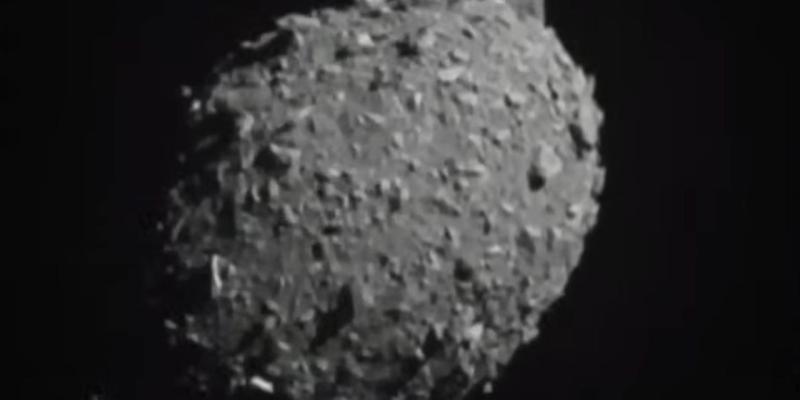NASA's DART Spacecraft to Crash Into Asteroid Tonight in Planetary Defense Test



An uncrewed spacecraft smashed into an asteroid Monday in an effort to deflect the distant space rock, the dramatic climax of a National Aeronautics and Space Administration mission to test whether the technique could one day be used to protect Earth.
"We're all just losing our minds right now," said Harrison Agrusa, a University of Maryland astrophysicist and investigation team member on the Double Asteroid Redirection Test, or DART, mission.
“I just can’t believe it went, as far as I know, exactly according to plan,” he said from the Johns Hopkins University Applied Physics Laboratory in Laurel, Md. The research center built the DART spacecraft and was responsible for its operation at the direction of NASA’s Planetary Defense Coordination Office.
The 1,300-pound DART spacecraft was traveling at more than 14,000 miles an hour when it hit the asteroid Dimorphos, a much more massive, 525-foot-wide space rock that orbits a larger one known as Didymos. The asteroid pair—what astronomers call a binary asteroid—was about 7 million miles from Earth at the time of impact and isn’t a threat to our planet.
“There’s a zero percent chance that this asteroid will come towards the Earth,” Dr. Bobby Braun, head of the space exploration sector at the Johns Hopkins University APL, said in a press briefing prior to the impact.
NASA live-streamed the impact, which occurred at about 7:15 p.m. ET, using imagery from a camera aboard the spacecraft. The craft was instantaneously destroyed.
Orchestrating a collision millions of miles away with a relatively small asteroid that scientists know little about was tricky business, according to mission systems engineers.
Round-trip radio signals between the DART spacecraft and mission team on Earth took more than a minute. That time lag meant the team members couldn’t effectively steer the craft. Instead, DART steered itself using its onboard navigation system, said Dr. Andrew Cheng, a Johns Hopkins APL planetary scientist and a DART investigation team lead. The spacecraft only glimpsed Dimorphos about an hour before impact, which meant it had scant time to lock on to its target and use its onboard thrusters to make course corrections.
NASA’s James Webb and Hubble space telescopes will help scientists analyze the results of the celestial smashup. So will nearly 40 Earth-based observatories across all seven continents.
“As far as telescopes here on the Earth are concerned, this is going to be the best data they’ve ever gotten for this system,” said Nancy Chabot, another Johns Hopkins APL planetary scientist and DART coordination lead.
“They’re going to be able to take observations through all of 2022 and into even 2023,” she added.
Observations have shown that Dimorphos takes 11 hours and 55 minutes to complete one orbit around Didymos. The DART team expects this so-called orbital period to be shorter now.
Dimorphos’ orbital period “could go down anywhere between seven-ish minutes to maybe even up to an hour,” Dr. Agrusa said.
He said that the shift depends in part on Dimorphos’ density and composition, which for now remain unclear.
It will take scientists weeks to determine the extent of that orbital period change and thus how effective the deflection was, Dr. Chabot said, adding that observations of the binary asteroid from ground-based telescopes are key to that effort.
On Sept. 11, the DART craft released a toaster-size spacecraft known as a cubesat that observed the crash on Monday. Images sent back to mission scientists on Earth from the Italian-built cubesat should help scientists determine the size of any impact crater made on Dimorphos as well as how much debris—what astronomers call ejecta—was sent careening into space.
“The team’s hopeful that we’re talking about days rather than weeks” for those images to become publicly available, Dr. Chabot said.
The DART spacecraft launched in November from Vandenberg Space Force Base in California aboard a SpaceX Falcon 9 rocket, and spent the last 10 months or so orbiting the sun on a trajectory that drew it closer to that of the asteroid system. Mission scientists chose the impact date because it came at a time when the system was relatively close to Earth, according to Dr. Chabot.

High-resolution camera detects
the asteroid so the spacecraft can
navigate. The camera will take photos
of the asteroid before impact.
Solar panels, which
unfurled from spacecraft
after launch, help test
onboard solar-powered
ion propulsion system.
27.9 feet
A future mission named Hera, helmed by the European Space Agency, is set to launch another spacecraft toward the binary asteroid system in about two years. That spacecraft will reach the system in 2026 with the goal of landing on Dimorphos and further characterizing any impact crater, as well as determining the asteroid’s composition and mass.
Although it dwarfed the DART spacecraft, Dimorphos is tiny compared with the six-mile-wide space rock that scientists believe doomed the dinosaurs . But even an asteroid of Dimorphos’ size would be big enough to cause regional devastation and cause “tens of billions of dollars in damage, not to mention lost lives,” if it were to collide with Earth, according to NASA’s planetary defense officer Lindley Johnson.
Mr. Johnson said the $325 million DART mission represents “a large step forward in showing that we do now have the knowledge and the technology to protect the Earth” from an asteroid such as Dimorphos.




This was a scientific feat. One that NASA & the US can be proud of.
A truly awesome event !
I couldn't agree more.
And congrats to fascist Italy, as this collision was recorded by LICIACube, or Light Italian CubeSat for Imaging of Asteroids.
This was a briefcase-size companion satellite provided by the Italian Space Agency. It deployed from the Dimorphos shortly before impact and traveled behind it to record the hit.
Several minutes after impact, the CubeSat flew by Dimorphos to continue to collect images and video. This info will be streamed back to ground stations over the next week.
Extraterrestrial whack-an-asteroid